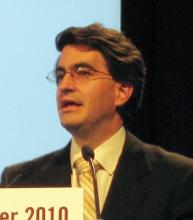MILAN – The investigational oral agent afatinib tripled median progression-free survival, but failed to extend overall survival in the third- and fourth-line setting of non–small cell lung cancer in the LUX-Lung 1 trial.
The primary outcome of median overall survival was 10.78 months for afatinib plus best supportive care and 11.96 months for best supportive care plus placebo (hazard ratio, 1.07; log-rank P = .74), Dr. Vincent Miller reported from a late-breaking abstract during the presidential symposium at the annual congress of the European Society for Medical Oncology.
Median progression-free survival by independent review increased from 1.1 months in the placebo arm to 3.3 months in the afatinib arm (HR, 0.38; log rank P less than .0001). A robust and consistent benefit was seen across all subgroups, he said. The disease control rate also tripled with afatinib.
LUX-Lung 1 compared afatinib 50 mg once daily plus best supportive care vs. best supportive care plus placebo in 585 patients with stage IIIB/IV adenocarcinoma of the lung. All had progressed after one or two lines of chemotherapy, including one platinum-based regimen, and at least 12 weeks of treatment with the epidermal growth factor receptor (EGFR) tyrosine kinase inhibitors (TKIs) erlotinib (Tarceva) or gefitinib (Iressa).
Afatinib, also known as BIBW 2992, is an irreversible TKI that is highly specific for EGFR and HER2, and has shown preclinical activity against EGFR-mutant tumors that also possess the T790M mutation.
Although the presence of EGFR-activating mutation in non–small cell lung cancer (NSCLC) confers sensitivity to EGFR TKIs, patients who are sensitive to gefitinib or erlotinib eventually progress, Dr. Miller explained. The T790NM mutation is the most common cause of resistance, detected in about half of such patients.
Despite the lack of overall survival benefit, he remained optimistic about the potential value of afatinib, noting that it induced objective regressions in a population with no or limited treatment options.
After at least 8 weeks of therapy, the disease control rate by independent review was significantly higher at 58% in the afatinib arm vs. 19% in the placebo arm (P less than .0001), said Dr. Miller of Memorial Sloan-Kettering Cancer Center in New York City.
Just 0.5% of controls had an unconfirmed or confirmed partial response, compared with 13% and 7%, respectively, of afatinib patients (P less than .01 for both). Dr. Miller reported stable disease after at least 8 weeks of therapy in 51% of patients on afatinib vs. 18% on placebo. The median duration of confirmed response was 24 weeks.
“These results, I believe, are both clinically and statistically significant,” he said.
Patients receiving afatinib also reported significant improvements in prespecified lung cancer–related symptoms including cough, dyspnea, and pain.
The safety profile of afatinib was as expected, with diarrhea (17% with grade 3) and rash (14% with grade 3) predominating, Dr. Miller said. In all, 8% of patients discontinued afatinib because of a treatment-related adverse event, compared with 1% on placebo.
Serious treatment-related adverse events were reported in 10% of afatinib patients and 1% of placebo patients. Two deaths were considered attributable to afatinib: one cardiac syndrome with heart failure and one hepatic and renal failure, he said.
The median survival of nearly 1 year was unexpected and could be explained in part by subsequent therapy that was received by patients, as well as by inherently favorable biology in patients who have EGFR mutations, Dr. Miller said. In all, 68% of afatinib and 79% of placebo patients did so, with pemetrexed chemotherapy being the treatment of choice at 36% and 47%, respectively.
Dr. Miller said that the results of EGFR mutation profiling, including the presence or absence of T790M mutation, were not complete and would be reported at a later date.
Even without the EGFR data, invited discussant Dr. Jean-Charles Soria said the unprecedented survival time in both arms was probably related to the trial population’s being highly selected. Most notably, 100% had adenocarcinoma, 60% were East Asian (an ethnicity known to have higher EGFR mutation rates), 60% were never- or light smokers, and 25% had a performance status of 0, even in the third- and fourth-line setting.
“That’s not what we have in our clinical daily practice in Western cultures,” he said. “This is a population that was very sensitive to previous EGFR mutation.”
Overall survival also may have been confounded by the heavy use of subsequent treatments. “At the end of the day, they are comparing afatinib vs. further chemotherapy with pemetrexed,” said Dr. Soria, a professor of medicine and medical oncology at the Institut de Canc?rologie Gustave Roussy in Villejuif, France.

